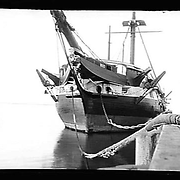
Glass negative - HMVS Nelson, Williamstown, Victoria, Apr 1898
Details
The Nelson was a hulk (ship) anchored off Williamstown, Hobson Bay. From 1868, it housed boys aged ten who had been sentenced under the Neglected and Criminal Children's Act of 1864. By 1872, the vessel housed 383 boys. It was abandoned in 1876 when the boys were transferred to the Bendigo Benevolent Asylum Industrial School, Sandhurst, and later to Sunbury Industrial School.
The hulk Nelson was the site of one of the industrial schools established in Victoria following the passage of the Neglected and Criminal Children's Act 1864. It was designated as a training ship for boys aged ten or over. It was anchored off Williamstown.
The Nelson was one of four ships used as industrial schools in Hobson's Bay, Victoria: Sir Harry Smith, the Nelson, the Deborah and the Success, eventually housed approximately 500 boys.
The fitting-out of the Nelson took place in 1868. By 1872 the vessel housed 383 boys. It was abandoned on 9 August 1876 when it was considered an unsuitable environment for 'either the industrial or moral training of boys who are not expressly designed for a seafaring life'.
The boys were transferred to the Bendigo Benevolent Asylum Industrial School, Sandhurst and later to Sunbury Industrial School.
In 1871, the trainee sailors aboard the Nelson played a role in the first trials of the new iron-clad warship, the Cerberus, which had entered Port Phillip Bay for the first time in April of that year. The Cerberus travelled to Geelong with boys from the Nelson joining its crew, as well as the Nelson's band who provided entertainment on a number of occasions during the Cerberus's three week stay in Geelong.
As The Nelson was a training ship, the boys followed naval routine. Their strict daily routine included doing their laundry on Wednesday mornings and Religious Instruction on Thursdays (Anglican in the morning and Catholic in the afternoon). Hours of schooling ranged from between six hours 45 minutes one week to nine hours the next. They sat at desks and had access to maps, blackboards, books and slates.
Their uniform consisted of a white jumper bound in blue with their number on the back, white pants, a flannel shirt and a cloth cap with the letters NTS with their number on it as well. The number was used to identify boys when they absconded or came to the attention of authorities when on shore leave. They slept in hammocks and the older boys had to wake for two duty watches.
The Nelson was criticised in the report of the Royal Commission on Industrial and Reformatory Schools in 1872, which called for the 'training ship' to be closed, declaring:
…a ship … is not … a fitting place for either the industrial or moral training of boys who are not expressly designed for a sea-faring life. The associations connected with ship life also induce, in the majority of them, a unsettled and roving disposition, quite at variance with them afterwards betaking themselves to steady industry on shore.
George Oliphant Duncan believed that as only a small number of the boys became sailors, it would be a much better use of public money to instruct them in 'agricultural and other rural avocations' so that they could find employment in country areas after leaving school. They would then add to the productive labour force of the colony.
Sources used to compile this entry: 'The 1871 visit of the Cerberus to Geelong: as reported by various newspapers', in HMVS Cerberus, Friends of the Cerberus Inc., http://www.cerberus.com.au/geelong_visit.html; Brogden, Joan, Neglected or criminal? The Sunbury Industrial School - Sunbury and beyond, vol. 2, The Author, 1997; Guillaume, George; Connor, Edward C., The Development and Working of the Reformatory and Preventive Systems in the Colony of Victoria, Australia, 1864-1890, Government Printer, Melbourne, 1891. Also available at http://handle.slv.vic.gov.au/10381/243591.
Prepared by: Cate O'Neill and Natasha Story
Created: 5 June 2009, Last modified: 30 October 2018